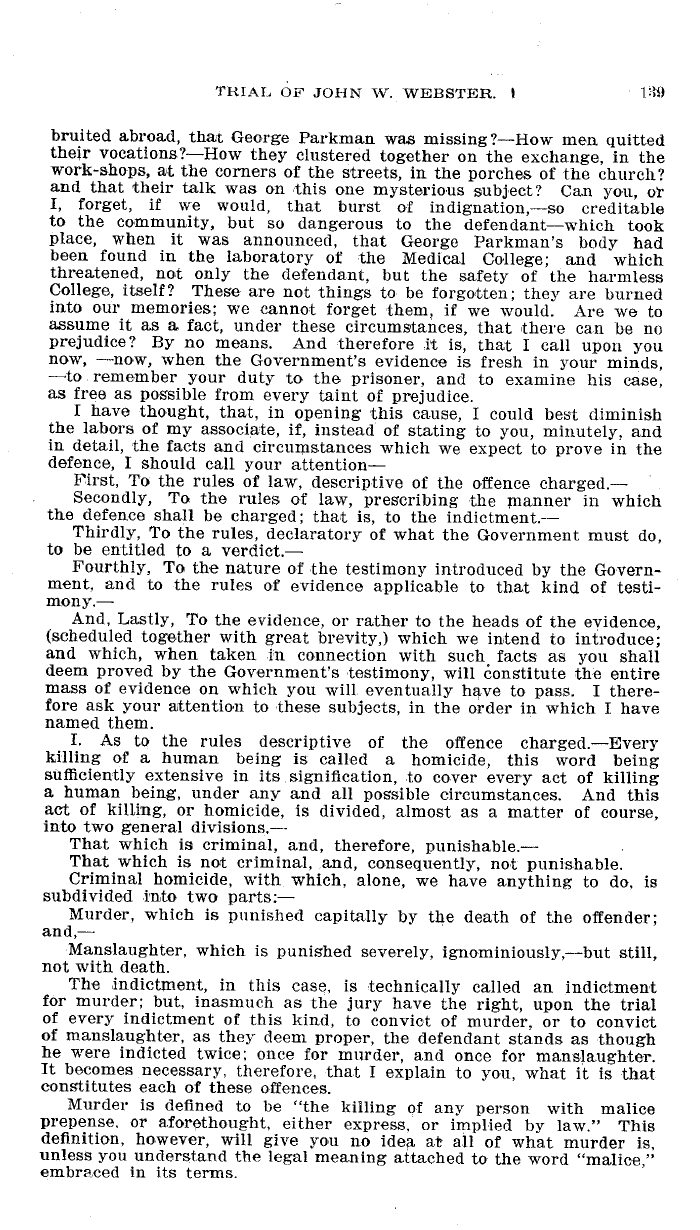|
TRIAL Or JOHN W. WEBSTER. 1 laic
bruited abroad, that George Parkman was missing?-How men quitted
their vocations?-How they clustered together on the exchange, in the
work-shops, at the corners of the streets, in the porches of the church?
and that their talk was on this one mysterious subject? Can you, or
I, forget, if we would, that burst of indignation,-so creditable
to the community, but so dangerous to the defendant-which took
place, when it was announced, that George Yarkman's body had
been found in the laboratory of the Medical College; and which
threatened, not only the defendant, but the safety of the harmless
College, itself? These are not things to be forgotten; they, are burned
into our memories; we cannot forget them, if we would. Are we to
assume it as a fact, under these circumstances, that there can be no
prejudice? By no means. And therefore it is, that I call upon you
now, -now, when the Government's evidence is fresh in your minds,
-to remember your duty to the prisoner, and to examine his case,
as free as possible from every taint of prejudice.
I have thought, that, in opening this cause, I could best diminish
the labors of my associate, if, instead of stating to you, minutely, and
in detail, the facts and circumstances which we expect to prove in the
defence, I should call your attention-
First, To the rules of law, descriptive of the offence charged.-
Secondly, To the rules of law, prescribing the manner in which
the defence shall be charged; that is, to the indictment.--
Thirdly, To the rules, declaratory of what the Government must do,
to be entitled to a verdict.-
Fourthiy, To the nature of the testimony introduced by the Govern-
ment, and to the rules of evidence applicable to that kind of testi-
monp.-
And, Lastly, To the evidence or rather to the heads of the evidence,
(scheduled together with great brevity,) which we intend to introduce;
and which, when taken in connection with such facts as you shall
deem proved by the Government's testimony, will constitute the entire
mass of evidence on which you will eventually have to pass. I there-
fore ask your attention to these subjects, in the order in which I have
named them.
I. As to the rules descriptive of the offence charged.-Every
killing of a human being is called a homicide, this word being
sufficiently extensive in its signification, to cover every act of killing
a human being, under any and all possible circumstances. And this
act of killing, or homicide, is divided, almost as a matter of course,
into two general divisions.--
That which is criminal, and, therefore, punishable.-
That which is not criminal, and, consequently, not punishable.
Criminal homicide, with which, alone, we have anything to do, is
subdivided into two parts:
Murder, which is punished capitally by the death of the offender;
and,-
Manslaughter, which is punished severely, ignominiously,-but still,
not with death.
The indictment, in this case, is technically called an indictment
for murder; but, inasmuch as the jury have the right, upon the trial
of every indictment of this kind, to convict of murder, or to convict
of manslaughter, as they- deem proper, the defendant stands as though
he were indicted twice; once for murder, and once for manslaughter.
It becomes necessary, therefore, that I explain to you, what it is that
constitutes each of these offences.
Murder is defined to be "the killing of any person with malice
prepense, or aforethought, either express, or implied by law." This
definition, however, will give you no idea at all of what murder is,
unless you understand the legal meaning attached to the word "malice,"
embraced in its terms.
|

